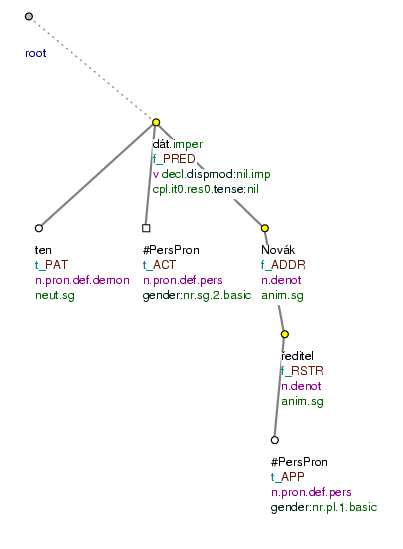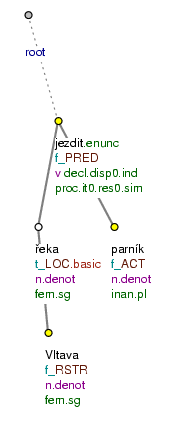Ambiguous semantic relations can also be found between elements of certain noun phrases. Particularly those noun phrases that are formed by several nouns in the same form (the connection of which is not loose as in apposition) are problematic. Example:
Dej to panu premiérovi Zemanovi. (=lit. Give it (to) (the) prime_minister Zeman.)
na řece Vltavě (=lit. on (the) river Vltava)
k panu starostovi (=lit. to Mr. mayor)
o nebožtíku panu kormidelníkovi Landgermanovi (=lit. about (the) deceased Mr. helmsman Landgerman)
Exact annotation rules have been defined for combinations of two (or more) nouns in which one of the nouns is a proper noun.
Loose connections of nouns in the same form (separated by a comma or by an appositional conjunction) are represented as appositions (see Section 6.2, "Coordination and apposition"). For annotation rules of noun phrases with the so-called nominative of identity see Section 8.1, "Basic rules for the annotation of identifying expressions".
The annotation of noun phrases in which there are two nouns in the same form (a common noun and a proper noun) differ depending on whether:
-
the noun phrase is a name of a person.
If a noun phrase with two nouns represents a name of a single person, the node representing the proper noun is the governing node of the entire collocation. The node representing the common noun depends on the node for the proper noun and it has the functor
RSTR. Cf.:-
předseda.
RSTRZeman (=lit. (the) chairman Zeman)The noun phrase předseda Zeman (=lit. (the) chairman Zeman) consisting of the proper noun (Zeman) and the common noun (předseda (=chairman)), which is a name of a person, will be represented by two nodes. The common noun will be dependent on the proper noun and it will have the functor
RSTR.
Other examples:
Dej to našemu řediteli .
RSTRNovákovi (=lit.Give it (to) our director Novák). Fig. 6.197Máme Zemana předsedu .
RSTRa Zemana ministra.RSTR(=lit. (We) have Zeman, a chairman and Zeman, a minister)Havlíček kritik.
RSTR(=lit. Havlíček (a) critic) ( Havlíček-kritik is represented in the same way)Combinations of more than two nouns. In noun phrases where there are more than two nouns referring to a person and in which one of the nouns is the name proper of the person, all the common nouns depend on the proper noun and their functor is
RSTR. Cf.:-
Dej to panu.
RSTRpremiérovi .RSTRZemanovi(=lit. Give it (to) Mr. prime_minister Zeman.)In the noun phrase panu premiérovi Zemanovi (=lit. (to) Mr. prime_minister Zeman) consisting of the proper noun (Zeman) and two common nouns (pan (Mr.) and premier (=prime_minister )), which is a name of a person, the node representing the proper noun is the governing node. The nodes representing the common nouns always depend on the node representing the proper noun (they are sister nodes)) and their functor is
RSTR.
Other examples:
o nebožtíku .
RSTRpanu.RSTRkormidelníkovi .RSTRMr. Landgermanovi (=lit. about the deceased Mr. helmsman Landgerman)paní .
RSTRdoktorka.RSTRVeselá (=lit. Mrs. doctor Veselá) -
-
the noun phrase is not a name of a person.
If a noun phrase is name of an animal, an inanimate object or some other phenomenon, the common noun is the governing node of the noun phrase. The node representing the proper noun depends on the common noun and its functor is
RSTR. Cf.:-
Na řece Vltavě.
RSTRjezdí parníky (=lit. On (the) river Vltava are_floating steamboats.)The noun phrase na řece Vltavě (=lit. on (the) river Vltava) consisting of a proper noun (Vltava) and a common noun (řeka (=river)), which is not a name of a person, is represented by two nodes. The node representing the proper noun will be the dependent one and its functor will be
RSTR. Cf. Fig. 6.198.
Another example:
do města Prahy.
RSTR(=lit. to (the) city (of) Prague) -
A noun phrase in the nominative. In the noun phrases that express names of persons, both parts have regular inflection. A combination of a common noun and a proper noun in the nominative is considered to be a case of two inflected nouns, not a case of the nominative of identity. In noun phrases that are names of animals, objects or other phenomena, the proper noun, on the other hand, has usually the form of the nominative of identity. If such a noun phrase is in the nominative, the proper noun has the functor ID (see Section 8.1, "Basic rules for the annotation of identifying expressions"). Compare:
-
jedeme do Prahy.
DIR3(=lit. (we) are_going to Prague) -
jedeme do města.
DIR3Prahy.RSTR(=lit. (we) are_going to (the) city (of) Prague.) -
jedeme do města.
DIR3Groznyj.ID(=lit. (we) are_going to (the) city (of) Groznyj.) -
město .
ACTPraha.IDbylo založeno už dávno (=lit. (the) city (of) Prague was founded - long_time_ago.).
-
Mám rád Čapka.
PAT(=lit. (I) - like Čapek.) -
Mám rád spisovatele.
RSTRČapka.PAT(=lit. (I) - like (the) writer Čapek.) -
Spisovatel.
RSTRČapek.ACTje mým nejoblíbenějším spisovatelem (=lit. (the) writer Čapek is my favourite writer.)
For annotation rules concerning the expressions consisting of more parts (e.g. Jan Maria Plojhar, Frýdek-Místek) see Section 8.2.1, "Specific rules for certain types of proper nouns".
The annotation of other types of noun phrases with the nouns in the same form (particularly those formed by common nouns) depends on the decision of the annotator. The context and the annotation rules for noun phrases with proper nouns described above are taken into consideration.
The node representing one of the inflected nouns is chosen to be the effective root node of the entire noun phrase. The other nodes depend on this effective root node as its modifications and their functor is RSTR.
Examples:
O nebožtíku panu kormidelníkovi se už nemluvilo.(=lit. About (the) deceased Mr. helmsman - any_more was_not_talked.)
Odnes to našemu panu starostovi (=lit. Take it (to) our mr. chairman).
žena-matka (=woman-mother)
tenista-důchodce(=lit. (a) tennis player-pensioner)

